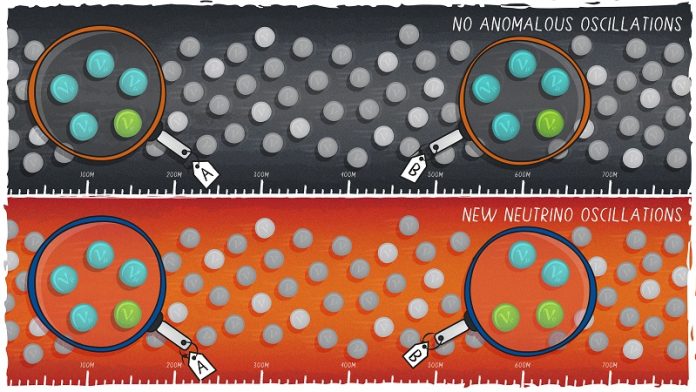
Scientists working on the Short-Baseline Near Detector (SBND) at Fermilab have made an exciting breakthrough—they have detected the first neutrino interactions.
This marks a major milestone after nearly a decade of planning, building, and testing the detector.
Neutrinos are some of the most mysterious and abundant particles in the universe, but they are incredibly hard to detect because they rarely interact with other matter.
Despite their abundance, neutrinos only interact through gravity and the weak nuclear force, making them “ghostly” particles.
The SBND is the final piece of Fermilab’s Short-Baseline Neutrino (SBN) Program, designed to help answer long-standing questions in particle physics.
The program includes two other detectors—ICARUS, which started collecting data in 2021, and MicroBooNE, which finished its experiments in the same year. Together, these detectors will help scientists investigate the mysteries surrounding neutrinos, especially the possibility of a new, unknown type of neutrino.
Neutrinos come in three known types, or “flavors”: muon, electron, and tau. One of the strangest things about neutrinos is that they can change from one flavor to another as they travel through space.
Scientists know how many neutrinos of each type should be present at different distances from a neutrino source. However, previous experiments have shown surprising results that suggest there could be more than the three known neutrino types.
Scientists suspect that there might be a fourth type of neutrino, which does not interact in the usual ways. This new neutrino could explain the differences in the number of neutrinos detected in earlier experiments.
The SBND detector, located close to the Fermilab neutrino beam, will measure the neutrinos as they are produced. Meanwhile, the ICARUS detector, located farther away, will measure the neutrinos after they have had time to oscillate (change flavors).
By comparing the data from both detectors, scientists will get a clearer picture of what is happening with neutrinos as they travel and whether this mysterious fourth neutrino exists.
David Schmitz, co-leader of the SBND team, said, “Understanding the anomalies from previous experiments has been a major goal in the field for the last 25 years. Now, with SBND and ICARUS, we have a great chance to test if this fourth neutrino really exists.”
In addition to searching for new neutrinos, SBND will also gather important information about how neutrinos interact with matter. Located close to the neutrino beam, SBND will see 7,000 neutrino interactions every day, providing scientists with a massive amount of data. The detector is made from liquid argon, and when a neutrino collides with an argon nucleus, it creates a spray of particles that scientists can study.
Understanding how neutrinos interact with argon is particularly important for future experiments like the Deep Underground Neutrino Experiment (DUNE), which will use liquid argon to detect neutrinos over long distances. SBND will collect 10 times more data on these interactions than all previous experiments combined, helping to improve future research.
While neutrinos are the main focus of SBND, the detector may also uncover other unexpected particles. The particle beam at Fermilab could produce particles that scientists haven’t yet discovered, potentially revealing clues about dark matter. Dark matter makes up most of the matter in the universe, but we don’t yet know what it is. SBND could detect lightweight particles that are part of the “dark sector,” giving scientists their first glimpse of dark matter particles.
With the first neutrino interactions successfully detected, the SBND collaboration is ready for the next phase of research. The team will continue collecting and analyzing millions of neutrino interactions over the coming years. As they gather more data, scientists hope to make groundbreaking discoveries about neutrinos and other particles that could change our understanding of the universe.
As Fermilab scientist Ornella Palamara put it, “Seeing these first neutrinos is the start of a long journey that we’ve been working toward for years. This moment marks the beginning of a new era for the collaboration.”



